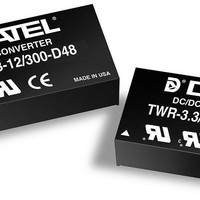TWR-3.3/4-15/250-D48N-C Murata Power Solutions Inc, TWR-3.3/4-15/250-D48N-C Datasheet - Page 5

TWR-3.3/4-15/250-D48N-C
Manufacturer Part Number
TWR-3.3/4-15/250-D48N-C
Description
DC/DC TH 22W 48-3.3/15V Triple XWR
Manufacturer
Murata Power Solutions Inc
Series
TWRr
Datasheet
1.TWR-3.34-15250-D24-C.pdf
(9 pages)
Specifications of TWR-3.3/4-15/250-D48N-C
Product
Isolated
Output Power
13 W
Input Voltage Range
36 V to 75 V
Input Voltage (nominal)
48 V
Number Of Outputs
3
Output Voltage (channel 1)
3.3 V
Output Current (channel 1)
4 A
Output Voltage (channel 2)
15 V
Output Current (channel 2)
250 mA
Output Voltage (channel 3)
+/- 15 V
Output Current (channel 3)
0.25 A
Isolation Voltage
1.5 KV
Lead Free Status / Rohs Status
Lead free / RoHS Compliant
Safety Considerations
certifi cation or regulatory requirements. These vary widely but generally
are concerned with properly sized conductors, adequate clearance between
higher voltage circuits, life testing, thermal stress analysis of components and
fl ammability of components.
Remote On/Off Control
converter by remote signal. For positive logic models (no model number
suffi x), if this pin is left open, the converter will always be enabled as long
as proper input power is present. On/Off signal currents are referred to the
Input Common pin on the converter. There is a short time delay of several mil-
liseconds (see the specifi cations) for turn on, assuming there is no signifi cant
external output capacitance.
off) using the “N” model number suffi x. For negative logic, the On/Off pin must
be grounded or pulled LOW to turn on the unit. Positive logic models must
have this control pin pulled down for shutoff. Negative logic models must pull
up this control pin for shutoff.
cal relay, solid state relay (SSR), an open collector or open drain transistor,
CPU bit or a logic gate. The pull down current is 18mA max. for "N" models.
Observe the voltage limits listed in the specifi cations for proper operation.
Suggested circuits are shown below.
The TWR’s must be installed with consideration for any local safety,
The TWR models include an input pin which can turn on or shut off the
The On/Off Control may also be supplied with negative logic (LO = on, HI =
Dynamic control of this On/Off input is best done with either a mechani-
HI = ON
LO = OFF
(for positive
On/Off)
CMOS
LOGIC
Figure 4. On/Off Control With An External Transistor (positive logic)
Figure 3. On/Off Control With An External CMOS Gate
+INPUT
ON/OFF
CONTROL
COMMON
SIGNAL
GROUND
CONTROLLER
www.murata-ps.com
Isolation Considerations
inputs from the outputs. Ideal “fl oating” isolation implies ZERO CURRENT fl ow-
ing between the two Common return sections of the input and output up to the
working isolation voltage limit. Real-world isolation on this converter includes
both an AC current path (through some small coupling capacitance) and some
DC leakage current between the two ground systems. To avoid diffi culties
in your application, be sure that there are not wideband, high amplitude AC
difference voltages between the two ground systems. In addition, ground dif-
ference voltages applied by your external circuits which exceed the isolation
voltage, even momentarily, may damage the converter’s isolation barrier. This
can either destroy the converter or instantly render it non-isolated.
Current Limiting and Short Circuit Condition
will enter current limiting mode. The output voltage will decrease and the
converter will essentially deliver constant power. This is commonly called
power limiting.
operation and the PWM controller will shut down. Following a time-out
period, the converter will automatically attempt to restart. If the short circuit
is detected again, the converter will shut down and the cycle will repeat. This
operation is called hiccup autorecovery. Please be aware that excessive exter-
nal output capacitance may interfere with the hiccup autorestart.
Output Filtering and Noise Reduction
ates both through the wiring (conducted emission) and is broadcast into the
air (radiated emission). This output noise may be attenuated by adding a small
amount of capacitance in parallel with the output terminals. Please refer to the
maximum output capacitance in the Specifi cations.
(near the converter versus near the load), the distance from the converter to
the load (and resulting series inductance), the topology and locations of load
elements if there are multiple parallel loads and the nature of the loads. For
switching loads such as CPU’s and logic, this last item recommends that small
bypass capacitors be placed directly at the load. Very high clock speeds sug-
gest smaller caps unless the instantaneous current changes are high. If the
load is a precision high-gain linear section, additional fi ltering and shielding
may be needed.
capacitance is indicated, observe these factors:
1. Understand the noise-reduction objective. Are you improving the switching
2. Use just enough capacitance to achieve your objective. Additional capaci-
These converters use both transformer and optical coupling to isolate the
As the output load increases above its maximum rated value, the converter
If the current continues to increase, the converter will enter short circuit
All switching DC/DC converters produce wideband output noise which radi-
The amount of capacitance to add depends on the placement of the cap
Many applications will need no additional capacitance. However, if more
threshold of digital logic to reduce errors? (This may need only a small
amount of extra capacitance). Or do you need very low noise for a precision
linear “front end”?
tance trades off increasing instability (actually adding noise rather than
reducing it), poor settling response, possible ringing or outright oscilla-
tion by the converter. Excessive capacitance may also disable the hiccup
autorestart. Do not exceed the maximum output capacitance specifi cation.
Isolated, High Reliability 1" x 2" DC/DC Converters
Triple Output/TWR Models
07 Jan 2011 MDC_TWR22.B03 Page 5 of 9
email: sales@murata-ps.com






















